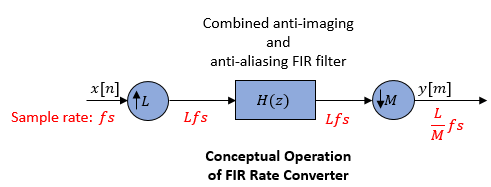dsp.FIRRateConverter
Perform polyphase FIR sample rate conversion
Description
The dsp.FIRRateConverter
System object™ performs an efficient polyphase sample rate conversion using a rational factor
L/M along the first dimension.
The FIR rate converter cascades an interpolator with a decimator. Conceptually, the rate
converter (as shown in the schematic) consists of an upsampler, followed by a combined
anti-imaging and anti-aliasing FIR filter, followed by a downsampler. The coefficients of the
anti-imaging and anti-aliasing FIR filter can be specified through the
Numerator property, or can be automatically designed by the object
using the designMultirateFIR function. For an example, see
Resample Signal Using FIR Rate Converter.
The upsampler increases the sample rate of the signal by a factor L and the downsampler reduces the sample rate of the signal by a factor M. Use upsampling and downsampling factors that are relatively prime or coprime. The resulting discrete-time signal has a sample rate that is L/M times the original sample rate.

Note that the actual object algorithm implements a polyphase structure, an efficient equivalent of the combined system depicted in the diagram. For more details, see Algorithms.
To perform sampling rate conversion:
Create the
dsp.FIRRateConverterobject and set its properties.Call the object with arguments, as if it were a function.
To learn more about how System objects work, see What Are System Objects?
Creation
Syntax
Description
firrc = dsp.FIRRateConverterdesignMultirateFIR(3,2) function.
firrc = dsp.FIRRateConverter(L,M)InterpolationFactor property set to L and the
DecimationFactor property set to M. The object
designs its filter coefficients based on the rate conversion factors that you specify
while creating the object, using the designMultirateFIR(L,M)
function. The designed filter corresponds to a lowpass filter with normalized cutoff
frequency no greater than min(π/L,π/M) in radial frequency
units.
firrc = dsp.FIRRateConverter(L,M,"Auto")NumeratorSource property is set to
"Auto". In this mode, every time there is an
update in the rate conversion factors, the object redesigns the filter
using the design method specified in
DesignMethod.
firrc = dsp.FIRRateConverter(L,M,num)Numerator property set
to num.
firrc = dsp.FIRRateConverter(L,M,method)DesignMethod property set to
method. When you pass the design method as an
input, the NumeratorSource property is
automatically set to "Auto".
firrc = dsp.FIRRateConverter(___,Name=Value)
Example: firrc =
dsp.FIRRateConverter(FullPrecisionOverride="false")
enables the fixed-point data types to be controlled through the
individual fixed-point property settings.
firrc = dsp.FIRRateConverter(L,M,"legacy")firpm(70,[0 0.28 0.32 1],[1 1 0
0]). The designed filter has a cutoff frequency of π/3
radians/sample.
Properties
Usage
Syntax
Input Arguments
Output Arguments
Object Functions
To use an object function, specify the
System object as the first input argument. For
example, to release system resources of a System object named obj, use
this syntax:
release(obj)
Examples
More About
Algorithms
The FIR rate converter is implemented efficiently using a polyphase structure.
To derive the polyphase structure, start with the transfer function of the FIR filter: This FIR filter is a combined anti-imaging and anti-aliasing filter.
N+1 is the length of the FIR filter.
You can rearrange this equation as follows:
L is the number of polyphase components, and its value equals the interpolation factor that you specify.
You can write this equation as:
E0(zL), E1(zL), ..., EL-1(zL) are polyphase components of the FIR filter H(z).
Conceptually, the FIR rate converter contains an upsampler, followed by a combined anti-imaging, anti-aliasing FIR filter H(z), which is followed by a downsampler.

Replace H(z) with its polyphase representation.

Here is the multirate noble identity for interpolation.

Applying the noble identity for interpolation moves the upsampling operation to after the filtering operation. This move enables you to filter the signal at a lower rate.

You can replace the upsampling operator, delay block, and the adder with a commutator switch. To account for the downsampler that follows, the switch moves in steps of size M. The switch receives the first sample from branch 0 and moves in the counter clockwise direction, each time skipping M−1 branches.
As an example, consider a rate converter with L set to 5 and M set to 3. The polyphase components are E0(z), E1(z), E2(z), E3(z), and E4(z). The switch starts on the first branch 0, skips branches 1 and 2, receives the next sample from branch 3, then skips branches 4 and 0, receives the next sample from branch 2, and so on. The sequence of branches from which the switch receives the data sample is [0, 3, 1, 4, 2, 0, 3, 1, ….].
The rate converter implements the L/M conversion by first applying the interpolation factor L to the incoming data, and using the commutator switch at the end to receive only 1 in M samples, effectively accounting for the downsampling factor M. Hence, the sample rate at the output of the FIR rate converter is Lfs/M.

Extended Capabilities
Version History
Introduced in R2012aSee Also
Functions
freqz|freqzmr|filterAnalyzer|info|cost|coeffs|polyphase|outputDelay|designRateConverter


